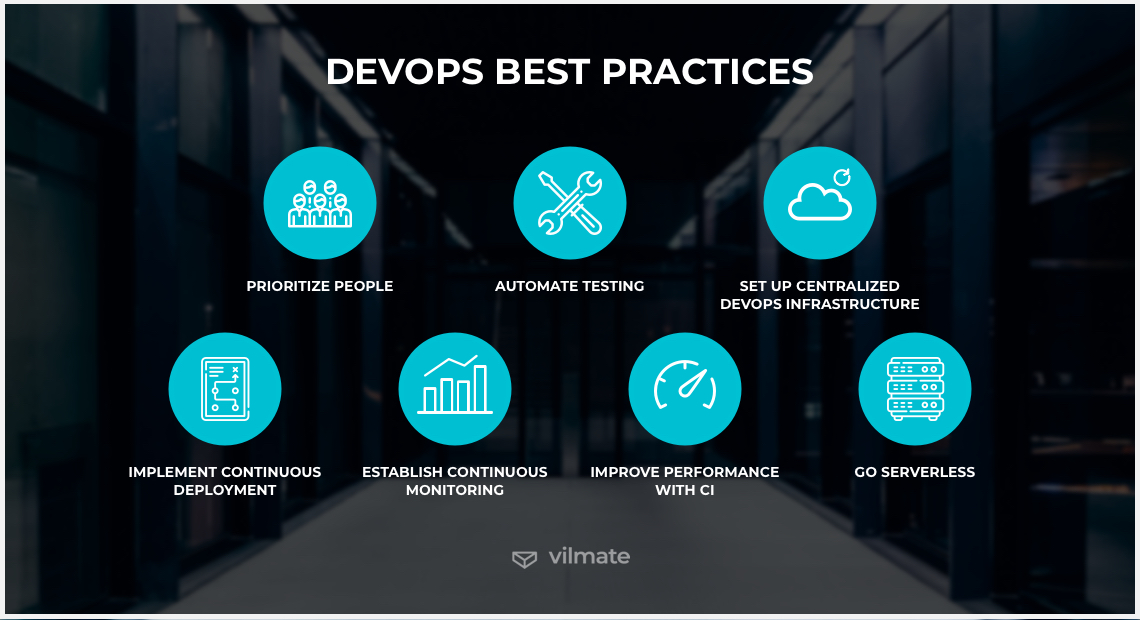DevOps has established its position in the global software development community and is being incorporated by more and more organizations around the globe. It effectively facilitates the resolution of certain types of problems and challenges that may occur throughout the project lifecycle. The set of tools, skills, and processes required to support the processes can vary significantly for each team to find what works best for them. Accordingly, now, there is much concern not about whether to adopt the DevOps practices but about how to best implement them so that to derive maximum business value.
In today’s article, we’re going to discuss what DevOps is and what best practices one should follow in order to make the most of what it has to offer.
What is DevOps?
DevOps is a mindset that is oriented towards IT processes fine-tuning. It is not a new concept but certainly an overhyped one. DevOps does streamline and accelerate innovation through continuous improvement, continuous delivery, and release automation. But this is only possible when the team applies these practices wisely. The goal is to see the performance grow and notice the room for future improvement thus making smart and informed decisions about process planning and organization.
According to the State of DevOps 2019 report by Google, these are the latest DevOps trends that help determine its value for the industry:
-
The DevOps field keeps evolving, especially among the high performers.
-
DevOps is the transformation that focuses on improved organizational performance achieved through quick, reliable, and safe software delivery.
-
Community structures are at the core of scaling DevOps in organizations.
-
The highest-performing teams prefer cloud computing.
-
A culture of psychological safety at the workplace drives productivity.
-
The way an organization handles the change approval process must be easy to understand for everyone.
What are the DevOps best practices?
With due regard to the software development and DevOps best practices highlighted by Google Cloud Platform and DORA (DevOps Research and Assessment) in their report, we suggest any company that is attempting to introduce DevOps in their work culture should consider the 7 best practices we are going to consider in detail below.

1. Prioritize people, then focus on processes and technologies
Although this may sound very similar to one of the statements on the Agile Manifesto, it proves workable in the context of DevOps practices as well.
People, processes, and tools are the three pillars of a software development project. When embracing a DevOps culture, they must be properly aligned with the current needs. Processes organization that results in a minimized SDLC time and the right infrastructure of tools and technologies will, no doubt, promote seamless DevOps implementation. However, teams and in particular, people on those teams must be made a priority. There must be a feeling of community, sharing a common goal, and contributing to the common cause. And for this to happen, management has to aim at keeping all teams on the same page.
As DevOps principles suggest, all stakeholders who are related to development, operation, and deployment have to be in the loop.
In the ideal scenario, there must be communities of practice in an organization. These topic- or role-based communities are expected to contribute to efficient knowledge-sharing and exploration across teams. Thus, since DevOps is all about working with other departments, communities on the topic of DevOps normally attract participants performing different roles in a company to exchange practices and experiences in building highly productive environments.
And it’s important to keep everyone on the same page while doing so. DevOps is the practice of development and operations staff participating together in the service lifecycle, so it’s vital to keep every team member on the radar.
2. Automate testing to support the SDLC
The implementation of the DevOps practices will most probably entail the adoption of automated testing to support that global change. In the context of DevOps, test automation, in the first place, means an automated infrastructure equipped with the means for continuous code and data quality checking.
For the code to be high-quality, it needs regular testing. So, test automation will accelerate the SDLC and allow developers to fix issues on the go. With DevOps in place, teams should follow the “test often, test early” approach in order to detect and rectify defects before they get into production. Automation will enable running more tests and saving time that could have been otherwise spent on manual testing. Testing of the middleware configuration, regular examination of networking and database changes, the development process support by means of automated load, unit, or regression testing – it all contributes to the SDLC optimization. Maintaining the flow of the software development life-cycle, automated testing results in the tested code being automatically promoted down the DevOps pipeline or being prevented from doing so if there are defects discovered.
3. Set up centralized DevOps infrastructure
DevOps strategy must rest upon a solid technological foundation. To put it in other words, DevOps teams have to consider designing a common tool strategy that would enable collaboration throughout development, testing, and deployment stages.
There are a wide variety of tools commonly used throughout the DevOps pipeline, including Jenkins, Splunk, Terraform, Nagios, Grafana, Prometheus, etc. Accordingly, there must be a certain management system realized so that centralized and federated IT would be well balanced in a DevOps transformation. The best way to organize the toolset is to first set up centralized IT practices, or a central way of doing provisioning, or security, or actual application deployment; then, one has to establish support for them through federated IT practices providing sufficient levels of flexibility and freedom around tools and technologies. This will help transition to a self-service developer-oriented DevOps model where people are organized around provisioning, security, and connectivity, and develop software in an API-driven way with easily accessible and searchable centralized source repositories in place.
4. Implement continuous deployment for enhanced throughput
Maintenance of high deployment frequency and stability is one of the fundamental principles of DevOps. Code deployment must be automated, repeatable, and predictable through small batches. Thus, teams that deploy more frequently than once a week can also fix code faster, address newly discovered security vulnerabilities promptly, and regularly deliver value to the customers. There will be no need to wait until the next scheduled update window to deploy emergency changes.
In order to promote more frequent deployments, one should consider a weekly agile sprint cadence. Then, it will be no problem to determine which teams can deliver value on a more frequent basis than others. Deployment frequency is a key metric, so this step towards regular performance review must be made by organizations willing to adopt DevOps practices. All of this will eventually let the organization involve in conversations about how to effectively adopt continuous delivery and automate processes.
The deployment stability is a continuous delivery indicator that informs a team about how successful a given repository is, and whether deployment subprocesses like code creation, versioning, testing, deployment, and post-deployment are well under control. It may help to visualize builds on a dashboard for teams to see clearly in which of them the deployment process should be optimized.
Limiting batch sizes helps teams improve overall throughput. So, observing their work-in-progress on the dashboard, a team can count the number of open issues and when it is higher than an established threshold, it's time to focus on the tasks they’ve already started instead of taking on new work.
5. Establish continuous monitoring and observability in CI/CD
This principle must not be ignored when trying to follow DevOps practices. Processes have to be continuously monitored to enable quick failure identification. The use of an integrated set of DevOps tools for monitoring will help create an environment where one can rapidly respond to problems, minimizing their impact on the business. It will improve visibility and make it easier to increase team productivity.
An efficient monitoring tool will cope equally great with containerized, cloud, and on-prem environments. It will allow planning adequately for upcoming upgrades or projects and manage resources accordingly. The most popular monitoring tools are Sensu, Prometheus, and Nagios. Also, there are DevOps alerting tools, including Slack, PagerDuty, and ServiceNow, that can provide teams with important information about the issues that occurred for them to act on. Tools like InfluxDB, Splunk, and AWS will serve as a metrics storage system that will help aggregate and learn from data collected. Finally, it is a good idea to consider using a DevOps visualization tool that will allow displaying combined and sorted data on a customizable dashboard.
The reasonable use of DevOps tools with the aim to create a solid monitoring ecosystem will expand the teams’ capabilities and enable them to improve the quality and value of the product or service they work on.
6. Improve performance with continuous integration
Enabling and practicing continuous integration can support collaborations between the groups and therefore improve overall performance. CI is a development practice of implementing small changes and checking in them to version control repositories regularly.
Given the diversity of tools and technologies used on a single project, there must be consistency in the integration process, so that teams could share a common mechanism of integrating and validating changes. Thus, by merging code back to the master branch early and often, they will be able to reduce the overhead of its integration. This will also lead to better collaboration and allow for fast feedback loops on the state of the code. Development teams practicing continuous integration will most probably have to configure automated tests to verify that their code changes didn’t break any existing features or tests.
7. Go serverless to induce positive organizational change
Serverless architecture can empower DevOps to realize its highest potential. Tools like AWS Lambda, Google Cloud Functions, Azure Functions, and Logic Apps are well equipped for running application code on serverless infrastructures to meet the unique needs of DevOps organizations.
This shift in IT architecture will also change how software developers and operations teams work together. As more operations and management tasks become handled by the serverless provider, the role of DevOps evolves so that teams can pay more attention to building and deploying apps instead of infrastructure management. Integrating Dev and Ops, serverless architectures help simplify DevOps processes and make many issues less concerning for teams. As a result, the introduction of serverless code causes a reduction in operating costs.
Conclusion
DevOps is not easy but it is definitely a change worth making. Besides, you won’t be alone in doing so. Many large enterprises and small to mid-sized organizations have embarked on this transformation and are struggling to do the most out of it. The DevOps best practices we discussed above can become a point of departure for your journey to success. Remember that the main objective of the DevOps transformation remains the same for any company – that is to positively impact productivity and efficiency, improve the software quality, and ultimately deliver value to customers as quickly as possible, be it through programming APIs, configuration management, build/integration/deployment processes, or automation. At the end of the day, DevOps has already proven to help businesses soar, so why not be next on the list?

© 2020, Vilmate LLC




